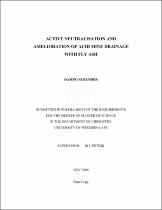| dc.description.abstract | Due to the constraints being placed on water resources and a drive for major industries to recycle waste water, improved and cheaper water treatment technologies are being investigated. During mining, pyrite (FeS2), a mineral naturally occurring in the earth’s structure, becomes oxidised when exposed to oxygen and water, resulting in the release of hydrogen ions, sulphate ions and metal cations. Coal mining
operations, located in one of the largest coalfields in the country, in Mpumalanga province, is a major contributor to the generation of acid mine drainage (AMD) and is estimated to produce 360 Ml/d after closure of the entire Mpumalanga Coalfields. Commonly applied chemically treatment processes for AMD involve the use of limestone to neutralise the AMD, however elevated sulphate concentrations persist in
the neutralised water. Membrane and ion exchange technology are more successful in attenuating sulphate in AMD; however, they are often complex and have exorbitant capital and operating costs. Universally, fly ash has been applied for the treatment of AMD primarily in passive
treatment systems. Passive treatment technologies require little or no operation and maintenance e.g. constructed wetlands and anoxic limestone drains. However, with specific reference to AMD treatment, passive treatment systems require long retention times and greater space as well as provide uncertain treatment efficiencies. Recent research has demonstrated the potential to apply fly ash in active treatment systems for AMD treatment and amelioration. Active treatment technologies make use of some chemical addition or advanced technology e.g. membrane technologies and ion exchange resins. Whilst active treatment technologies are often more expensive than
passive treatment systems, active treatment occurs at a faster rate and treatment efficiencies are more controllable and effective. This study investigated the potential of fly ash to actively neutralise and ameliorate or improve the quality of AMD at beaker and large scale with special attention given to sulphate attenuation. The results of the investigation were compared to data of state-of-the-art treatment technologies,
obtained from literature. These included chemical treatment, membrane treatment, ion exchange and biological treatment systems. A comparative study was conducted to ascertain the feasibility of fly ash versus the commonly used limestone treatment technology.
Fly ash and AMD samples were characterised by standard analytical methods for selection of the test materials. Active treatment by means of mixing fly ash with AMD in beakers and a large tank at pre-determined ratios have shown that fly ash is capable of neutralising AMD and increasing the pH beyond neutral values, which optimises the removal of heavy metals and ions. The trend was: the more fly ash added the quicker was the reaction time and higher the pH values achieved. Iron was reduced by as much 99 % in beaker scale experiments via Fe(OH)3 precipitation at pH values >4.0. A 99 % decrease in aluminium concentration was observed which was attributed to the precipitation of primarily gibbsite and various other mineral phases at pH values >5.5. As the pH increases, sulphate is adsorbed via Fe(OH)3 and gypsum
precipitation at elevated pH. Sulphate attenuation with fly ash was excellent, achieving 98 % attenuation with beaker scale experiments and 1:1 fly ash:AMD ratio. Sulphate attenuation with fly ash was comparable to membrane and ion exchange systems and exceeded the performance of limestone treatment. Except for the larger volumes of fly ash needed to neutralise the AMD, fly ash proved to be a feasible and cost efficient alternative to limestone treatment. Fly ash produced competing results to limestone concerning acidity removal and sulphate attenuation. The comparison highlighted the advantages of utilising fly ash in comparison to limestone and demonstrated its cost effectiveness. The results of this study have shown that fly ash could be successfully applied for the neutralisation of acid mine drainage (AMD) and effectively attenuate the sulphate load in the treated water. The critical parameters to this technology are the variations
of chemical composition and mineralogy of fly ash, which could influence the pH, contact time of the neutralisation reaction, and the same is true if the AMD quality varies. | en_US |

